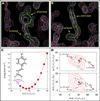Contradictions in X-ray structures of intermediates in the photocycle of photoactive yellow protein
- PMID: 24651178
- PMCID: PMC4217633
- DOI: 10.1038/nchem.1898
Contradictions in X-ray structures of intermediates in the photocycle of photoactive yellow protein
Figures

Comment in
-
Reply to 'contradictions in X-ray structures of intermediates in the photocycle of photoactive yellow protein'.Nat Chem. 2014 Apr;6(4):259-60. doi: 10.1038/nchem.1897. Nat Chem. 2014. PMID: 24651179 Free PMC article. No abstract available.
Comment on
-
Volume-conserving trans-cis isomerization pathways in photoactive yellow protein visualized by picosecond X-ray crystallography.Nat Chem. 2013 Mar;5(3):212-20. doi: 10.1038/nchem.1565. Epub 2013 Feb 3. Nat Chem. 2013. PMID: 23422563 Free PMC article.
References
-
- Groenhof G, et al. J. Am. Chem. Soc. 2004;126:4228–4233. - PubMed
Publication types
MeSH terms
Substances
Grants and funding
LinkOut - more resources
Full Text Sources
Other Literature Sources

